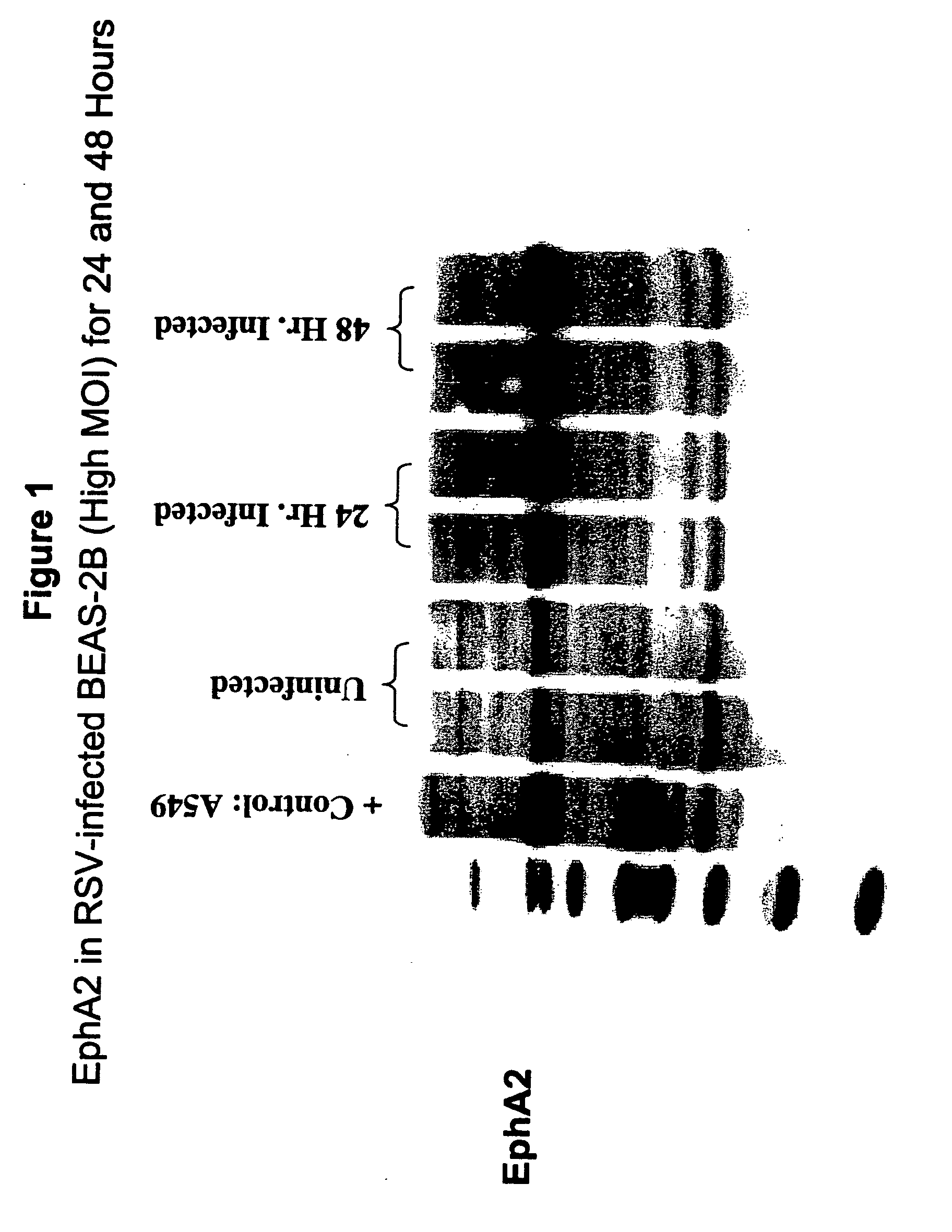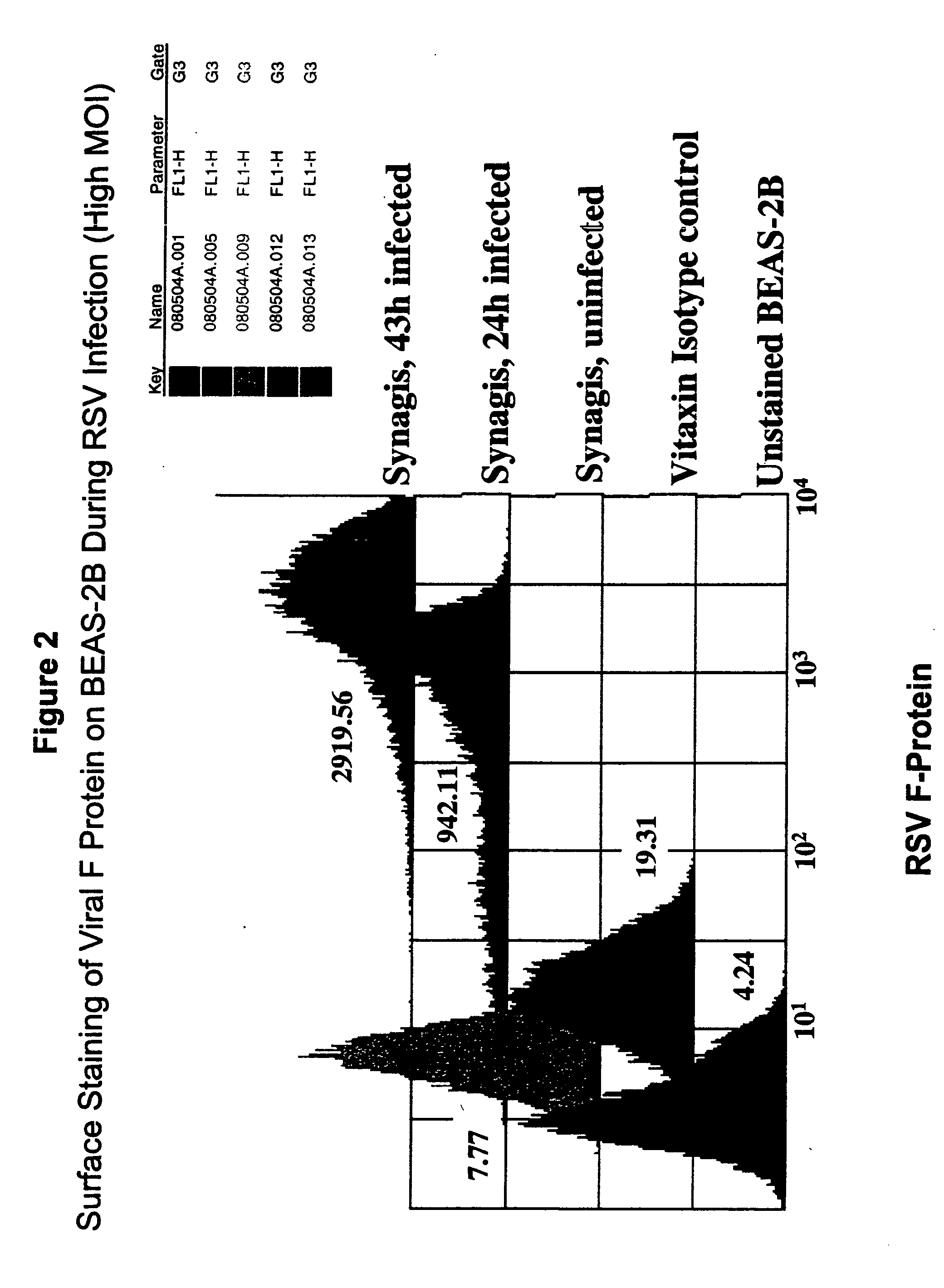Use of modulators of EphA2 and EphrinA1 for the treatment and prevention of infections
a technology of epha2 and ephrina1, which is applied in the direction of antibacterial agents, drug compositions, antibacterial ingredients, etc., can solve the problems of renal failure or bone marrow dysfunction, side effects outweigh the benefits of therapy administration to a subject, and prevent or reduce the interaction, prevent or reduce the interaction, and prevent or reduce the effect of epha2 signal transduction from very low to negligible levels
- Summary
- Abstract
- Description
- Claims
- Application Information
AI Technical Summary
Benefits of technology
Problems solved by technology
Method used
Image
Examples
example 1
6.2 Example 1
Detection of EphA2 on BEAS-2B Cells Using Western Blot Analysis
[0593] This example demonstrates that total EphA2 protein is increased following an infection with RSV using Western blot analysis (see FIG. 1).
Cell Culture
[0594] For cell culture, 60 mm plates were seeded with 10.sup.6 BEAS-2B cells in 5 ml BEGM. When the cells were -80% confluent, they were infected with RSV-A2.
RSV Infection
[0595] For infection of the cells, RSV-A2 stock, at a concentration of 1.8.times.10.sup.8 pfu / ml, was diluted in BEGM to 2.5.times.10.sup.7 pfu / ml, and BEAS-2B cells were infected with 1 ml of diluted virus. Plates were incubated at 37.degree. C., 5% CO.sub.2, for 2.5 hours with rocking every 30 minutes. After infection, the inoculum was removed and 5 ml fresh BEGM was added to the plate. Cells were incubated at 37.degree. C. and 5% CO.sub.2 for the indicated times.
Preparation of Cell Lysates
[0596] For preparation of the cell lysates, plates were chilled on ice during the lysis procedur...
example 2
6.3 Example 2
Detection of EphA2 on BEAS-2B Cells Using FACS Analysis
[0600] This example demonstrates the amount of RSV-F protein and EphA2 protein present on the surface of BEAS-2B cells infected with RSV increases, as measured by Fluorescence Activated Cell Sorting (FACS) (see FIGS. 2 and 3, respectively). FACS analysis measures the intensity of fluorescently labeled RSV-F protein or EphA2 protein on the cell surface and plots it as a histogram along the x-axis. The number of cells is plotted on the y-axis. The numbers beside each histogram are the mean fluorescence intensity (MFI). MFI is directly proportional to the amount of RSV-F protein or EphA2 protein on the cell surface. Thus, with respect to RSV-F protein, MFI is a measurement of the degree of infection of the cells.
Preparation of Cells
[0601] BEAS-2B cells were plated and infected as described in Example 1, supra.
[0602] At the indicated times after infection, the cells were washed once with PBS, then detached from the plat...
example 3
6.4 Example 3
Detection of EphA2 mRNA Expression in BEAS-2B Cells During RSV Infection
[0608] This example illustrates EphA2 expression at the transcriptional level increases after RSV infection of respiratory epithelial cells, as analyzed by RT-PCR.
Preparation of Cells
[0609] BEAS-2B cells were plated and infected as described in Example 1. Total RNA was isolated with the Total RNA Isolation Kit (Agilent Technologies, Palo Alto, Calif.) according to the manufacturer's instructions. RNA concentration was determined by A260.
RT-PCR
[0610] For RT-PCR, total RNA was isolated from BEAS-2B cells infected at one or two days, and mRNA of EphA2 was reverse transcribed and amplified by real-time PCR. RT-PCR was performed with 100 ng RNA as template using the TaqMan One Step RT-PCR Mastermix Kit and the ABI Assay on Demand for human EphA2, according to the manufacturer's instructions (Applied Biosystems, Foster City, Calif.). 18S rRNA primers were used in separate reactions as normalization contro...
PUM
| Property | Measurement | Unit |
|---|---|---|
| Mass | aaaaa | aaaaa |
| Mass | aaaaa | aaaaa |
| Time | aaaaa | aaaaa |
Abstract
Description
Claims
Application Information
 Login to View More
Login to View More - R&D
- Intellectual Property
- Life Sciences
- Materials
- Tech Scout
- Unparalleled Data Quality
- Higher Quality Content
- 60% Fewer Hallucinations
Browse by: Latest US Patents, China's latest patents, Technical Efficacy Thesaurus, Application Domain, Technology Topic, Popular Technical Reports.
© 2025 PatSnap. All rights reserved.Legal|Privacy policy|Modern Slavery Act Transparency Statement|Sitemap|About US| Contact US: help@patsnap.com



